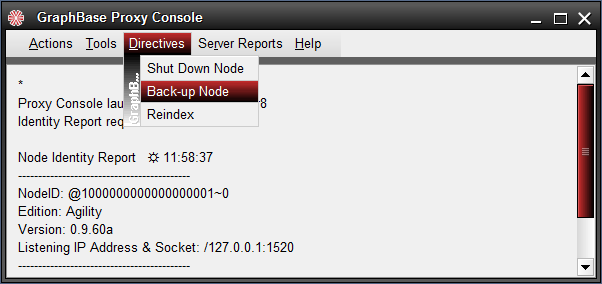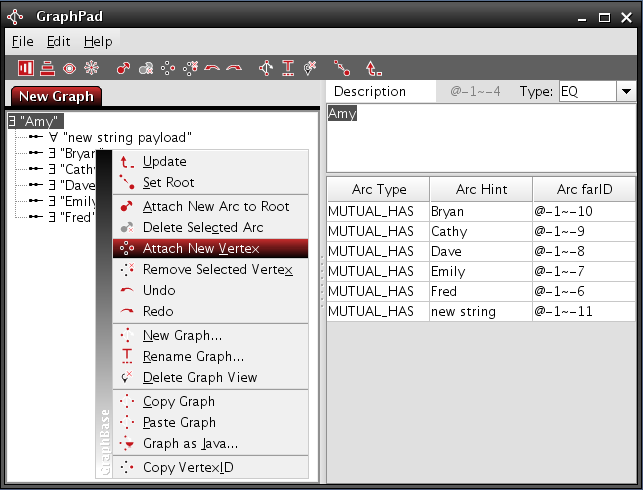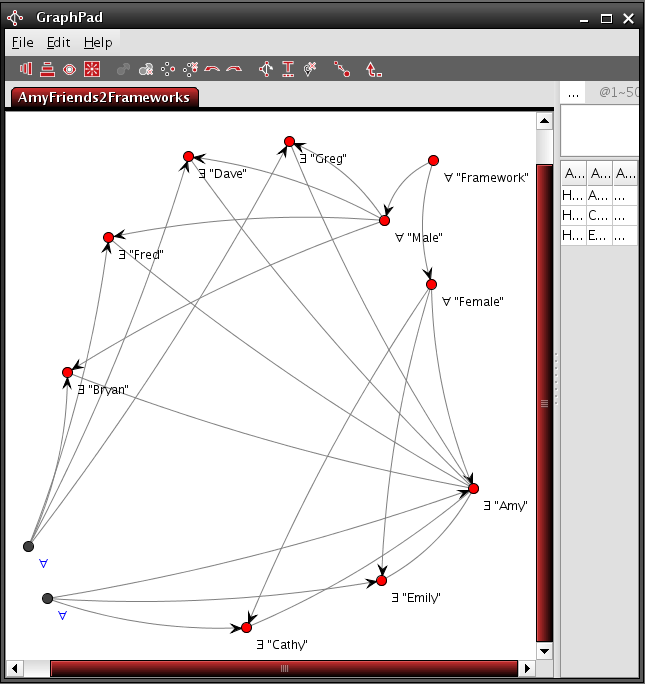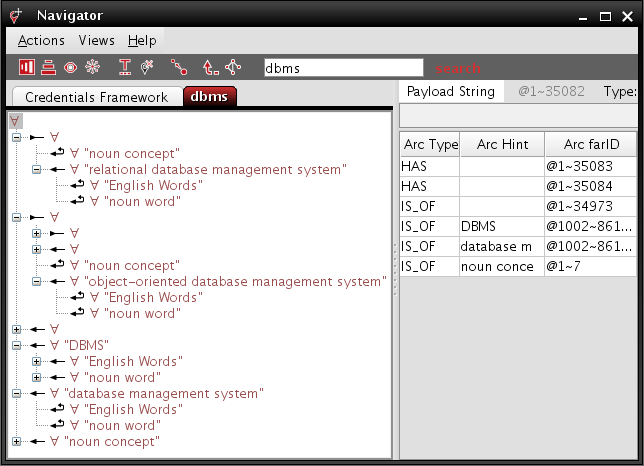The GraphBase Console is the first tool you'll see after launching. It's used to...

You can work locally with GraphPad and BoundsPad using JSON and XML files - but to use Navigator you must be connected to a remote GraphBase Cloud Node. You'll need to...
The GraphBase GraphPad is visual tool that allows you to create and manipulate GSF (Graph Simple Form) graphs.
The first thing you'll see when clicking up an instance of GraphPad is a "New Graph" tab. This new graph has a single vertex with a payload value of "new". Every time you attach a new vertex in GraphPad this is what you'll see. Edit this default payload in the text-box to the upper right. If the vertex doesn't need a payload, just delete the text.
In this screenshot, our first vertex is "Amy" and we're attaching six of her friends. [right-mouse-click] brings up a popup version of the "Edit" menu.

It may seem odd that the graph in the above screenshot is represented as a tree. Graph structures can quickly become a visual mess as you'll see in later images. Flattening them into trees usually makes it easier to see and comprehend the data that is attached to each vertex. This flattening process usually results in several vertices being represented in the tree multiple times. These "dupes" are always leaves and are flagged with a small "back-into-the-tree" arrow.
The three screens below show how a classic collabsible tree structure can make it easier to focus on a key vertex and its connections.

You'll also notice a couple of unusual symbols. We've borrowed these from predicate logic. "∀" is the Universal Quantifier (UQ) - effectively it means "this vertex represents all of these". "∃" is the Existentail Quantifier (EQ) - it means "this vertex represents some of these".
An arrow between two vertices indicates that the arc between them is directed. Direction indicates a simple subsumption or containment relationship, where a vertex either "has" or "is of" its connected neighbour.
See Graph Simple Form for a more detailed discussion on quantifiers, containment and other features of the graph structures used by these tools.

In the image above, a second framework has been added to the AmyFriends graph. The two black UQ vertices at the lower left are from the Universal Semantic Framework. Multiple frameworks or "schemas" are a powerful tool for managing graph complexity. Find out more in Understanding Frameworks.
GraphPad Tips
Use the View Buttons to explore your graph from varying perspectives...
Several keyboard/mouse actions can be used to speed graph-manipulation...
The GraphBase BoundsPad is a visual tool that allows you to create and modify a GraphBase query. This query is refered to as a Bounds object.

A Bounds object contains one or more simple expressions that define the scope of your graph query. Objects can be created using the GraphBase API, but they are often best worked-with using a Bounds Language statement. BoundsPad lets you work with both Bounds objects and Bounds Language statements. For more detail - including examples - see API Help.
BoundsPad Tips
The GraphBase Navigator lets you open one or more windows into a connected GraphBase Node.
Navigator is a version of GraphPad that displays non-editable views of a super-graph. Your super-graph is the single large graph that contains all of your GraphBase data. It can reside on multiple, geographically-distributed GraphBase Nodes and can be navigated by connecting to any one of those Nodes.A Navigator view window is created by...

The screen-shot above is a "dbms"-searched view of the Universal Semantic Framework mentioned above.
Navigator Tips
When you work with GraphBase, you work with graphs. GraphBase stores data as one large (usually connected) graph. Data is delivered to GraphBase as small graphs, a query to GraphBase returns data as a graph and the smallest transactional unit is a graph. GraphBase also contains visual tools that let you think about, manipulate, and store your data - as graphs.
The Graph class sample methods below are cut from the JavaDoc that comes with GraphBase Agility.
| Graph Sample Methods | ||
| static Graph | newSingleVertexGraph(GlobalID vertexID, int vertexType, java, lang, String vertexPayload) | Simplest factory method for creating a new Graph with a single vertex. |
| Graph | newAddedVertexGraph(VSet vSet, GlobalID farVertexID, int arcType) | Return a copy of this Graph with vSet added and attached to farVertexID. |
| Graph | and(Graph otherGraph) | Return a graph of vertices and arcs that are common to this and otherGraph. |
| Graph | newestOr(Graph otherGraph) | Return a graph of vertices and arcs found in either this or otherGraph. |
| Graph | subGraph(Bounds bounds) | Applies a Bounds query object to this graph and returns a sub-graph. |
| GlobalID[] | getLeafIDs() | Return an array of vertexIDs for those vSets that CONTAIN nothing. |
| < T > java.util.List | asObjectsList(GlobalID[] focusVertexIDs, T templateObject, java.util.Map translationMap) | Return a List of templateObject objects built using this graph. |
| boolean | saveAsJsonFile(java.io.File file) | Save Graph as a GraphBase Standard JSON file. |
The class comes with a wealth of functionality to let you create, manipulate, analyse and compare Graphs.
Download GraphSampleMethodsJava.txt to see these methods applied in a simple program.
A Bounds object is query that, when applied to a local Graph, or to a Super-Graph, returns a sub-graph. A Bounds query describes a set of simultaneous graph traversals together with the operations applied to, and between, those traversals. Each Bounds object contains...
The filter epression is composed of one or more simple filters - called ExpressionFragments - that are applied to either the arc type or the arc hint. The easiest way to work with these is to use Bounds Language.
Let's start by introducing the features, or tokens, used by the language. First up, some basic structural tokens that encapsulate and control evaluation order.
| Structural Tokens | ||
| Token | Name | Description |
| { | BOUNDS_OPEN | Opening Bounds encapsulation token. |
| } | BOUNDS_CLOSE | Closing Bounds encapsulation token. |
| ( | OPEN_BRACKET | Encapsulates a filter expression and overrides evaluation order. |
| ) | CLOSE_BRACKET | Encapsulates a filter expression and overrides evaluation order. |
| from | BOUNDS_FROM | Results will be taken FROM the following Bounds encapsulation. |
| pass | BOUNDS_PASS | PASS results of the following filter expression on. |
| to | BOUNDS_TO | Pass resulting vertices TO the following encapsulation. |
Tokens in this next block are used to filter on the type of a vertex's incident arcs.
| Arc Type Filter Operations | ||
| Token | Name | Description |
| all | ALL_ARCS | All of this vertex's incident arcs. |
| [ | ALL_CONTAINED_BY_THIS | Arcs with a type that implies far vertices are contained by this one. For GSF this means types HAS_A, MUTUAL_HAS and SAME_AS. |
| ] | ALL_CONTAINING_THIS | Arcs with a type that implies that far vertices contain this one. For GSF this means types IS_OF, MUTUAL_HAS and SAME_AS. |
| ![ | ALL_NOT_CONTAINED_BY_THIS | Arcs with a type that implies far vertices are not contained by this one. For GSF this means types IS_OF and SAME_AS. |
| !] | ALL_NOT_CONTAINING_THIS | Arcs with a type that implies that far vertices do no contain this one. For GSF this means types HAS_A and SAME_AS. |
| T= | TYPE_IS | Operand is an integer. Filter returns arcs of the operand's type. |
| T!= | TYPE_IS_NOT | Operand is an integer. Filter returns arcs NOT of the operand's type. |
Some examples...
{ from {@1~51397} pass All} - a graph of all vertices adjacent to a vertex of known ID.
{ from {@1~51397} pass [ } - vertices contained by this vertex.
Each arc may carry an heuristic or hint as to the contents of its pointed-to vertex. This feature allows arcs to behave as an adjacent index and it dramatically-improves query speed for graphs with known structure. Tokens for filtering using hints are these.
| Arc Hint Filter Operations | ||
| Token | Name | Description |
| H= | EQUAL_TO | Incident arcs where hint equals operand. |
| H!= | NOT_EQUAL_TO | Incident arcs where hint does not equal operand. |
| H> | GREATER_THAN | Arcs where hint is greater than operand. * |
| H>= | NOT_LESS_THAN | Arcs where hint is greater than or equal to operand. * |
| H< | LESS_THAN | Arcs where hint is less than operand. * |
| H<= | NOT_GREATER_THAN | Arcs where hint is less than or equal to operand. * |
| * String hints are evaluated in UTF-8 order. | ||
Some examples...
{ from {@1~1} pass H='name' to { pass H='Fred' }} - framework and arc hints as an index.
{ from {@1~1} pass H='age' to { pass H>18 }} - framework and arc hints as a range query.
Filter operations can be further refined by applying boolean operations to two or more expressions.
| Expression Association Operations - In Operation Precedence Order | ||
| Token | Name | Description |
| and | AND | Returns arcs that are common to both expressions. |
| or | OR | Returns arcs that are found in the results of either expression. |
| xor | XOR | Returns arcs that are found in the results of either expression but not in both. |
| andnot | AND_NOT | Returns arcs that are found in the results of the first expression, but not in the second |
| Use ( encapsulating brackets ) to ensure that evaluation order is as expected. | ||
Extending the above examples...
{ from {@1~1} pass H='name' to { pass H>'Fred' and H<'Free' }} - get Freddy, Frederick and other derivations.
{ from {@1~1} pass H='age' to { pass H>=18 and H<40 }} - over 18, but under 40.
| Expression Modifiers | ||
| Token | Name | Description |
| * | REACH | Applies the expression to the specified number of traversals. e.g *3 Default is 1. |
| # | RESULT_RANGE | Returns the range of expression results specified by the modifier indices. e.g. #1-100 |
Extending an earlier example above to perform three traversals using the same expression...
{ from {@1~51397} pass [ *3 } - applies the containment expression to successive results.
Similar operations can also be applied between evaluated Bounds objects. The result of a Bounds Association Operation is a complete Graph.
| Bounds Association Operations - In Operation Precedence Order | ||
| Token | Name | Description |
| AND | AND | Returns a graph of vertices that are common to the results of both Bounds objects. |
| XAND | XAND | As for AND, but eXtended to include the vertices used to traverse to the found common vertices. |
| OR | OR | Returns a graph of vertices that are found in the results of either Bounds objects. |
| XOR | XOR | Returns a graph of vertices that are found in the results of either Bounds objects but not in both. |
| ANDNOT | AND_NOT | Returns a graph of vertices that are found in the results of the first Bounds object, but not in the second. |
Putting it all together...
@1~51397 is the Semantic Framework conceptID for "actor".
See http://graphbase.net/semantic/@1~51397. This Bounds query returns a graph of Actors, 18 to 40 years of age. Use of the XAND operator ensures that the returned graph can be further explored using the same frameworks.
Bounds Language is the easiest way to create a new or simple Bounds query, but the Bounds API can be useful for complex queries or for the creation of Bounds queries that conform to regularly-used patterns.
Once you've connected to a GraphBase Node, you can query a super-graph, add to it or manipulate it via a Job Broker.